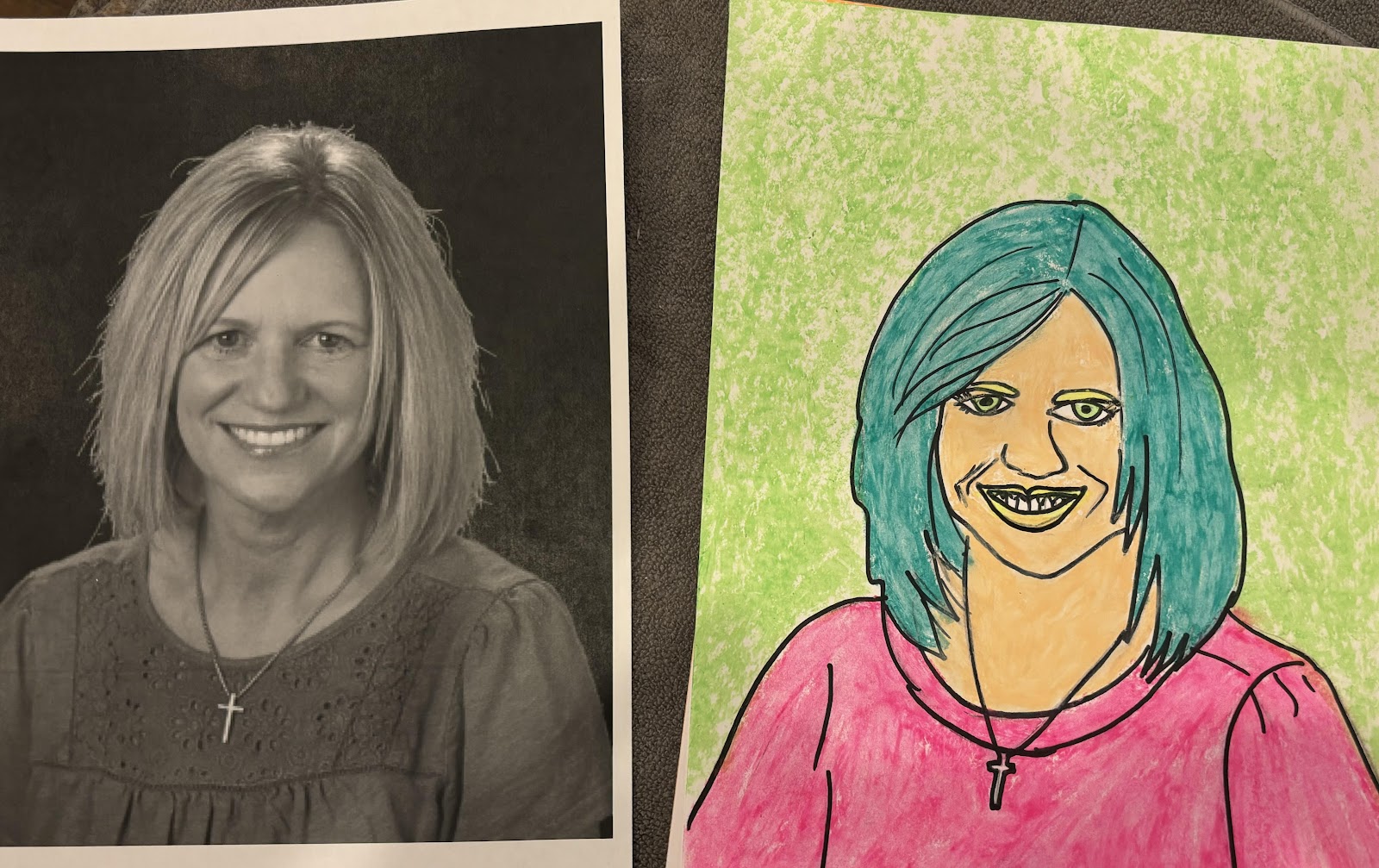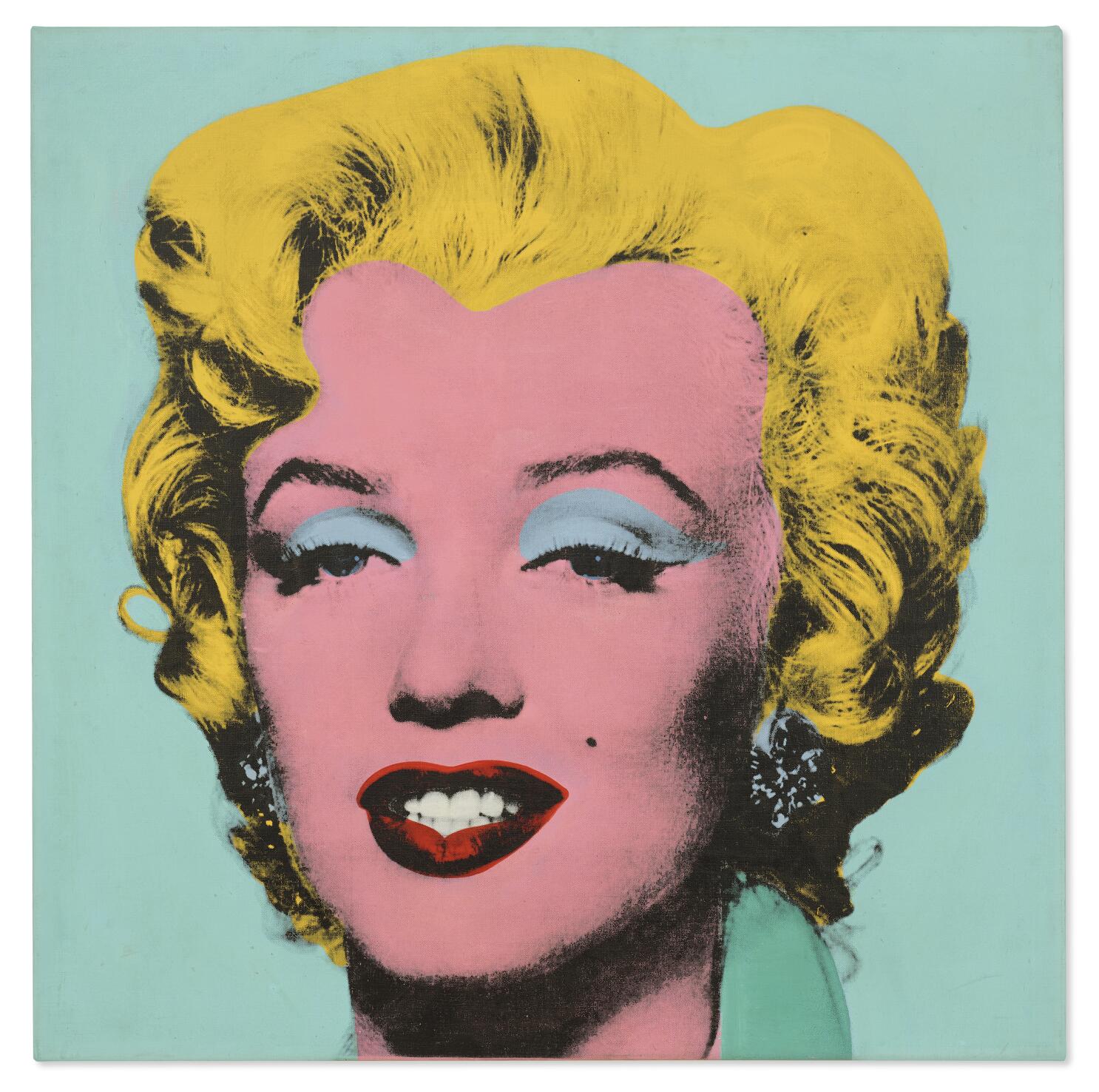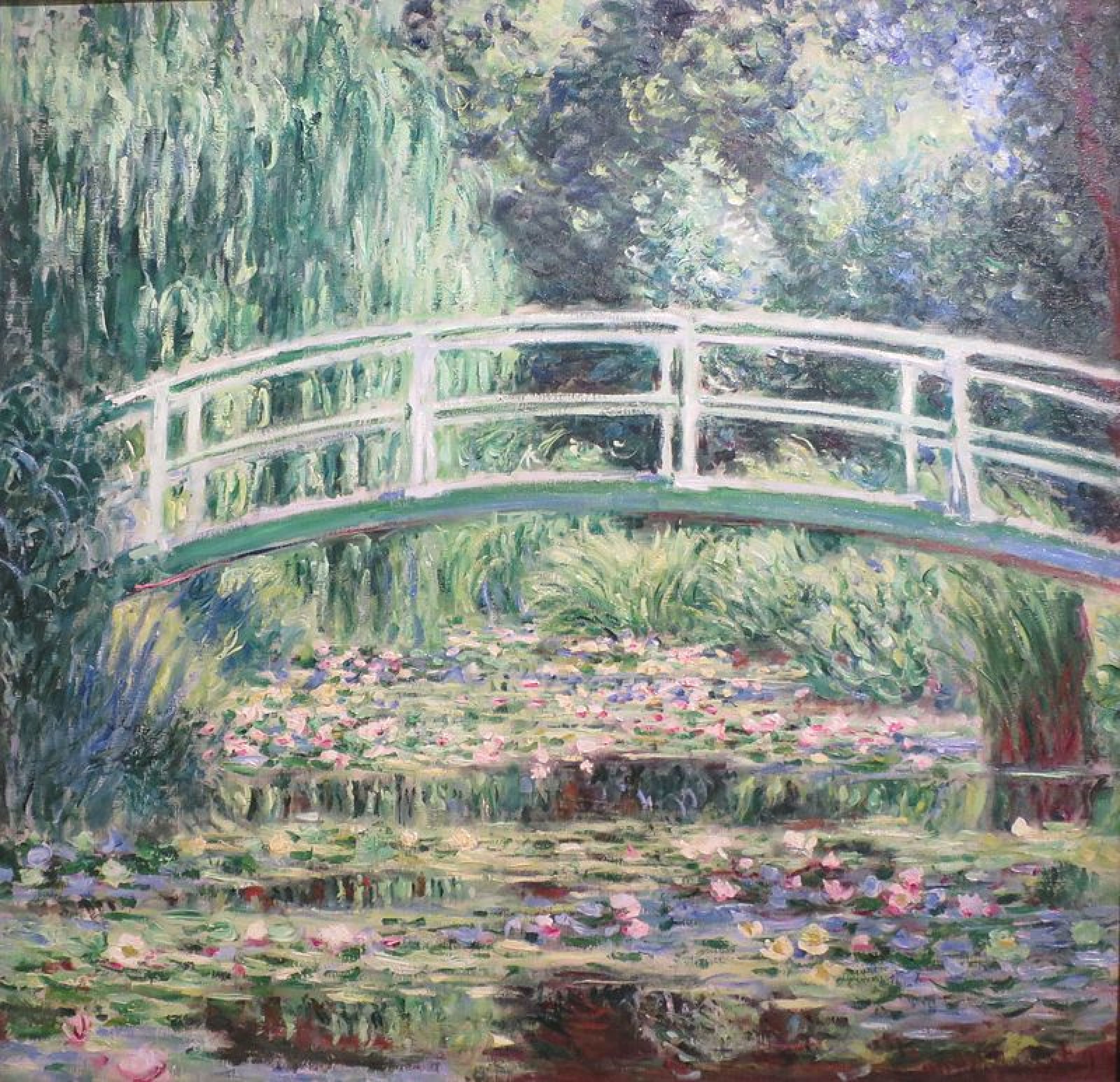POP ART SELF PORTRAITS
Author: Melissa Hooker
For this project students will be tracing their own photos to make an Andy Warhol inspired Pop Art Self portrait.
Click here to see the inspiration for this project. https://pin.it/4eFbtM3ZF
Supplies Needed:
Messy Mat
9x11 white paper
Pencil
Black Marker
Thin Black Marker
Color Wheel for each student
2 pieces of painters tape per student. Stick them on the color wheel where students can peel them off (see photo below)
Oil Pastels
Paper towel or wet wipe for each student
HOW I BEGIN EACH CLASS:
*this has proved successful for me, but its just an idea, you do you!
- - - Introduce yourself-who’s parent you are
- - Im not a teacher-so lets pratice how should I get your attention “class, class”, “quiet coyote”
- There are a lot of steps to this project, and we need to stick together so we all can finish on time. Sometimes with art, we get to take our time and do our own thing, but this is not one of those times. If you fall behind, you might not finish your project. I have done this project many times so I know how long each of these steps should take…..so I might encourage you to hurry up sometimes when you feel like you want to take your time…but its just because we only have a limited amount of time to make sure this whole project gets finished!
- When I pick up my marker, pencil, oil pastel...., you will put yours down. When I put mine down, you can pick yours up.
START PROJECT
1. SHOW THE FINISHED PROJECT OF WHAT THEY WILL CREATE
Each class has a teacher photo that is already finished. You can hang that up on the white board or just hold it up to show students how they will go from their black and white school photo to a bold, vibrant exciting self portrait that looks just like them!
2. HAVE STUDENTS FIND THEIR PHOTO
You can do this many ways.
I think the easiest would be to just set out their photo onto a work space and when the students arrive, they can find their photo and that is where they will sit. If you would like students to be able to sit wherever they want, they you could have them get seated first and then have the photos laid out on the front table and call each desk group up individually to find their photo.
TK, Kinder, 1st- their photos will already be traced for them in black marker and ready to skip to coloring. (also keep in mind these classes are only 45 minutes long)
2nd grade-their photos will be traced for them in pencil, and they will go over the pencil in black marker.
3rd, 4th & 5th grade- they will be doing the entire project themselves so they will only have a photo to find.
3. LABELING
Instead of writing their names on the back of their art work-We will have pre-printed name labels to be attached to the backside of their photos. Some classes may already be attached. For others, you will need to hand those out. This would be a great job for a parent helper or teacher to walk around and help students attach their label at any part during the project.
For 3rd, 4th & 5th the recommendation is to wait until they are finished with the black marker part of the project to pass these out in case you need to have any "re-dos"
3. TRACING
TK, K, 1st- They will not be tracing but you can talk with them about how an adult used their photo and traced their face. you can show them how did this by demonstrating on a window. Some of these photos have black marker ON the photo which made tracing easier, some of them don't. (skip to coloring)
2nd-Do above and then have them start by tracing the pencil lines with their black marker. For Teeth- we highly recommend having them switch to the thin marker! I would give them 5 minutes for this. (skip to coloring)
3rd, 4th, 5th- You will demonstrate the process for them. **TIP** While doing this I found that if I first traced directly onto their photo, it was SO MUCH EASIER to see it through our thick art paper. You don't have to trace every single part...but the parts of the face below would be very helpful!! Have them do each of these steps together so you can move through this quickly. Wherever there is dark to light contrast on the photo you will be able to see easily through the paper, where there is light on light...that is where this pre-tracing will be helpful. (SEE PHOTOS BELOW)
-hair line
-eyebrows
-eyes (pupils should be colored in black)
-nose
-smile lines
-lips
-teeth- switch to thin marker here
I probably would have the girl below trace her bow and also the full outline of her ears.
Give students two piece of painters tape. They will tape their photo to the window first and then their white piece of paper over top. Try to have them center it. You can have students leave the classroom to find an open window- probably best to sent a parent helper along too! :)
BEGIN TRACING WITH PENCIL !! I would allow no more than 6-7 minutes for this step. I might walk them through each step here (example: now we will trace our hair line, now we will trace our eyebrows....and for other classes, I may just have them go ahead.)
An important point here is that we are not taking every single itty bitty detail. Just the main details!! No need to trace any shirt details.
When the student is finished have them take their tracing off the window and double check that they traced everything before going back to their seat. Make sure they have a jaw line, eyeballs, etc. It's funny what you can miss.
5. RETURN TO YOUR SEAT AND TRACE YOUR PENCIL WITH BLACK MARKER - 5 minutes
*switch to the thin marker for teeth
LETS LEARN ABOUT ANDY WARHOL 1st Grade & up!
After tracing & coloring many photos, I figured out that if you trace and then go straight into coloring the marker has a tendency to smear. So, so give the marker a little bit of time to dry, I am going to stop here and ask them to put their markers down and talk a little bit about Andy Warhol. I have found that the students stay more engaged if I am the one sharing the information on the artist instead of having them watch a video. So I did research, got a lot of my information from this video here: https://youtu.be/DI5P_67AGgY?si=13C4IRlj6JkE7BZR and am going to talk about the points below. I think it would be a huge success if our students came out knowing the name Andy Warhol and also being able to recognize art inspired by him!!
I am going to show the powerpoint I emailed to each to you while I speak. There are also notes in the "notes section" of the power point.
Andy Warhol was a famous artist and is considered to be one of the most important American Artists in our history. He was born in Pittsburg Pennsylvania. When he was a little boy he loved to color and his mom rewarded him with chocolate when he finished coloring a page in his coloring book. He loved his mom so much that when he was older and moved out of his home, his mom moved in with him and lived with him until he was 43 years old.
When he was 9 years old, he got very sick with a disease called Chorea (core-e-uh). It's a nervous disorder and it left him in bed for many months. The Chorea disease caused Andy's skin and hair to lose pigment/color. That is why when you see a photo of him, his hair is always very white!
During that time, sick in bed, he spent a lot of time reading superman comic's, watching movies, coloring in his coloring books. It was during this time that Andy became obsessed with famous celebrities and wanted to become one himself. When he became an adult, Andy said he credits this time in life for his artist inspiration.
In the 1940’s our country was at war and the type of art being created looked like this . One type was called realism because It looked very realistic, showed people doing every day jobs. The other type was called abstract- which does not look like anything real.
In the 1950’s people were tired of what they called “boring drab art” and a new type of art emerged, called POP ART. Andy Warhol became one of the leading artists of a type of art called Pop Art. Pop stands for popular. Andy Warhol made art showing things that were really popular at the time. Things like celebrities, !!! What made his art so different was the use of really bold bright colors.
Marilyn Monroe was VERY popular during this time. She was one of the most famous faces in the world.
Andy Warhol took a photo of Marilyn Monroe and created this painting to the right. It’s called Shot Sage Blue Marilyn. This painting became very famous.
Andy Warhol became one of the leading artists of a type of art called Pop Art. Pop stands for popular. Andy Warhol made art showing things that were really popular at the time. Things like celebrities, cartoons like Mickey Mouse and even cans of soup!! What made his art so different was the use of really bold bright colors.
The other thing that made his art different is that he would copy his art over and over and then re-color it in a different way. Then he would hang those same pictures but different colors up together. by Andy Warhol. He did it with Marilyn Monroe, Mickey Mouse & Even Campbells Soup cans.
This is NOT done by Andy Warhol but if you ever see a painting that looks like this with the same image over and over in different colors….that is art inspired by andy Warhol!
If you wanted to buy one of Andy Warhol's original art pieces, like this one called Shot Sage Blue Marylin, you would have to pay 195 million dollars. That's how much it sold for in 2022. It's the most expensive art work ever sold by an American Artist!
Now let's move on to coloring our own self portrait in the bold fun bright colors like Andy Warhol used! And when we hang them up all together, it's going to look like a big huge Andy Warhol painting!
.
6. COLORING - leave yourself about 30 minutes for the coloring!
Students will be using bright neon oil pastels for coloring! When working with oil pastels, I like to remind students that these "look like crayons and somewhat act like crayons, but they are NOT crayons" They are much softer and the really special part is that they can be blended in with your finger so you don't see any coloring marks. Students should use medium pressure with oil pastels and not color every single white space. This is a great time for parent helpers to walk around and show students how to blend oil pastels with their finger. Make sure you have a paper towel at each desk setting for wiping dirty fingers.
7. BEGIN WITH SKIN
To make us look more realistic and allow all the other fun details to pop, we will be using flesh colored oil pastels for our skin. Each station will already have pale colored oil pastels because we have a lot of those, but we also have a few boxes of various skin colored oil pastels. (olive tones, browns, blacks) Hand those out as needed. Keep in mind students can combine two colors together to create a different tone if needed.
8. HAIR
move to hair next and get that all colored.
9. BACKGROUND
*when we practiced these during our Teaching Team Meeting, we gave the option of using either oil pastels in the background OR tempura paints. However, we have rethought that and we are only going to do oil pastels. They are much brighter and bolder and we think they look better!
When students have finished their hair, have them look at their color wheel and find a "complementary color". A complementary color is opposite whatever color their hair is. If they colored their hair pink then Green, yellow or light blue is on the opposite side and would make the best background color. It will help their face/hair pop off the page.
The best way to color the background is to use a small piece of an oil pastel and use the long side of it. It will cover a lot more space! Encourage creativity here. If students want to add some flair to their background, they are welcome to.
10. WHAT TO KEEP WHITE?
Teeth & the Whites of the eyes should be kept white! All other features are fair game for coloring
11. ALL OTHER FEATURES
we have found the best look is to keep eyes a "normal eye color" - so blue or green. You may suggest this and then allow students to do as they wish.
Any color's for clothing, eyebrows, lips, will work great. Students can get creative here.
12. ADD LABELS TO THE BACKSIDE OF THE SELF PORTRAIT
13. NAME/SIGNATURE CARD
Pass out a slip of paper to each student and have them either write or sign their name. First name, last initial would be perfect! Then use a paperclip to attach the signature card to the picture and place in the drying rack.



























































